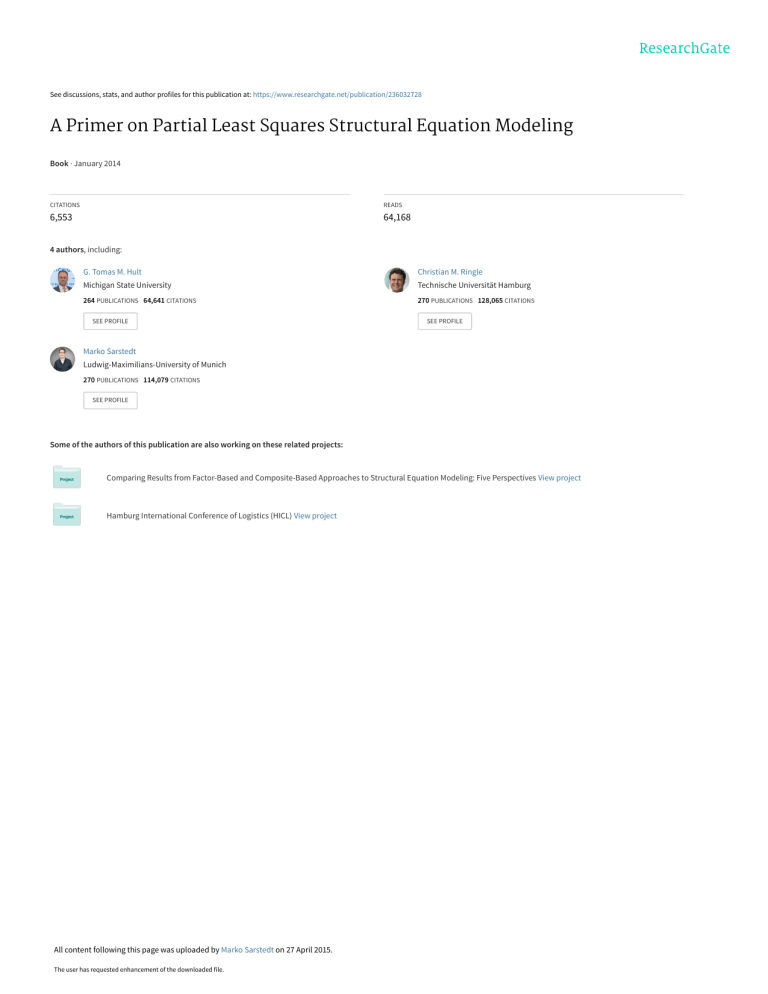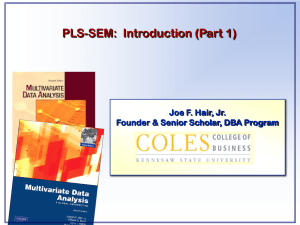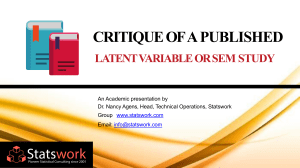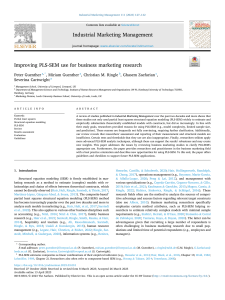
See discussions, stats, and author profiles for this publication at: https://www.researchgate.net/publication/236032728 A Primer on Partial Least Squares Structural Equation Modeling Book · January 2014 CITATIONS READS 6,553 64,168 4 authors, including: G. Tomas M. Hult Christian M. Ringle Michigan State University Technische Universität Hamburg 264 PUBLICATIONS 64,641 CITATIONS 270 PUBLICATIONS 128,065 CITATIONS SEE PROFILE SEE PROFILE Marko Sarstedt Ludwig-Maximilians-University of Munich 270 PUBLICATIONS 114,079 CITATIONS SEE PROFILE Some of the authors of this publication are also working on these related projects: Comparing Results from Factor-Based and Composite-Based Approaches to Structural Equation Modeling: Five Perspectives View project Hamburg International Conference of Logistics (HICL) View project All content following this page was uploaded by Marko Sarstedt on 27 April 2015. The user has requested enhancement of the downloaded file. A Primer on Partial Least Squares Structural Equation Modeling (PLS-SEM) Joseph F. Hair, Jr. Kennesaw State University G. Tomas M. Hult Michigan State University, East Lansing Christian Ringle Hamburg University of Technology (TUHH), Germany Marko Sarstedt Otto-von-Guericke University, Magdeburg Paperback 04-02-2013 ISBN: 9781452217444 $38.00 A Primer on Partial Least Squares Structural Equation Modeling (PLS-SEM), by Hair, Hult, Ringle, and Sarstedt, provides a concise yet very practical guide to understanding and using PLS structural equation modeling (PLS-SEM). PLSSEM is evolving as a statistical modeling technique and its use has increased exponentially in recent years within a variety of disciplines, due to the recognition that PLS-SEM’s distinctive methodological features make it a viable alternative to the more popular covariance-based SEM approach. This text includes extensive examples on SmartPLS software, and is accompanied by multiple data sets that are available for download from the accompanying website (www.pls-sem.com). INDEPENDENT CUSTOMER REVIEWS The book is well done and good for students who are no experts in statitics - Professor Udo Wagner, Faculty of Business, Economics and Statistics, University of Vienna This is great text book, very clear, comprehensive, and can be used both by the new to the field and as a handbook by those who already know the basic concepts. I have recommended this book to my Master students who are writing their dissertations and they were very pleased with it. - Mr Carlos Cândido, Faculty of Economics, University of the Algarves Excellent book covering both material and software previously unavailable in a quality textbook - Dr Mark Matthews, Clg Of Psych Behavioral Sci, Argosy University - Dallas TABLE OF CONTENTS Chapter One: Structural Equation Modeling Chapter Two: Specifying the Path Model and Collecting Data Chapter Three: Path Model Estimation Chapter Four: Assessing PLS-SEM Results Part I: Evaluation of Reflective Measurement Models For more information about this title, please visit sagepub.com To order, create a SAGE account at sagepub.com/myaccount, or contact Customer Service at (800) 818-7243 or (805) 499-9774. - Page 1 - A Primer on Partial Least Squares Structural Equation Modeling (PLS-SEM) Chapter Five: Assessing PLS-SEM Results Part II: Evaluation of the Formative Measurement Models Chapter Six: Assessing PLS-SEM Results Part III: Evaluation of the Structural Model Chapter Seven: Advanced Topics in PLS Path Modeling Chapter Eight: Modeling Heterogeneous Data FEATURES/NEW TO THIS EDITION KEY FEATURES: • This title provides simple instructions on how to use the SmartPLS software to obtain solutions, and to prepare manuscripts using the technique for submission to journals. •Designed to be easily understood even by those with limited statistical and mathematical training, the authors have limited the use of formulas, equations, Greek symbols, and similar notations. •“Rules of Thumb” in every chapter provide guidelines on best practices in the application and interpretation of PLS-SEM. •Chapters are organized around learning outcomes to simplify learning the concepts, and statistical terms. Concepts are consistently defined in simple words to facilitate an understanding of the method. •The book’s website includes many supplements and datasets to facilitate learning and teaching, and provides support to professors in the form of Microsoft® PowerPoint slides as well as an Instructor Guide that can be posted to their websites. For more information about this title, please visit sagepub.com To order, create a SAGE account at sagepub.com/myaccount, or contact Customer Service at (800) 818-7243 or (805) 499-9774. - Page 2 View publication stats








![A Primer on Partial Least Squares Structural Equation Modeling (PLS-SEM) [2nd ed.] by Joseph F. Hair, G. Tomas M. Hult, Christian M. Ringle, Marko Sarstedt (z-lib.org)](http://s2.studylib.net/store/data/027610740_1-96d323224889f6374cf63b82c72d14b7-300x300.png)